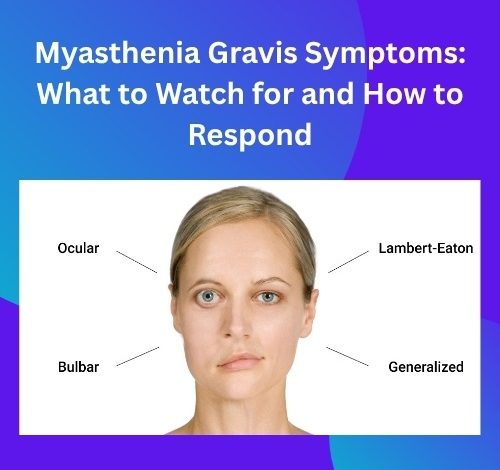Myasthenia Gravis Symptoms: What to Watch for and How to Respond

What is Myasthenia Gravis?
Myasthenia gravis is a chronic neuromuscular disorder that disrupts the communication between nerves and muscles. This interference leads to weakness in voluntary muscles—the ones you consciously control. The name itself means “grave muscle weakness,” but with proper management, many people live stable lives. Understanding what is the symptoms of myasthenia gravis helps people take quicker action and avoid worsening complications.
Why Symptoms Vary Between Individuals
The way this condition shows up isn’t the same for everyone. Symptoms can come and go, vary in severity, and often worsen with activity and improve with rest. In some, symptoms start mildly and progress over time, while in others, they remain stable for years.
Knowing what are the symptoms of myasthenia gravis and recognising them early offers a better chance at managing the disease effectively.
What Are the Most Common Early Symptoms of Myasthenia Gravis?
In most cases, early symptoms affect the eyes and facial muscles. These can easily be mistaken for stress or fatigue. Look out for:
1. Drooping Eyelids (Ptosis)
One of the earliest signs involves weakness in the muscles controlling the eyelids. You might notice one or both eyelids sagging, especially as the day progresses. This usually gets worse with physical or visual activity.
2. Double Vision (Diplopia)
Weakness in the muscles that move the eyes can lead to blurred or double vision. The images may appear side by side or on top of one another and often worsen when looking in specific directions.
3. Facial Muscle Fatigue
You might find it harder to smile, frown, or express emotion with your face. Chewing can become tiring, especially with tough foods. If your face feels heavy after eating or speaking, take note.
Recognising what are the most common early symptoms of myasthenia gravis can significantly improve the chances of early intervention.
Progressive Myasthenia Gravis Disease Symptoms
As the condition develops, weakness spreads to other areas of the body. The following symptoms of myasthenia gravis disease are important for recognising progression:
4. Difficulty Swallowing (Dysphagia)
Some people struggle to swallow foods or liquids. There may also be a risk of choking. If these problems become regular, they should not be ignored.
5. Weakness in the Neck and Limbs
You may find it hard to hold your head up, especially by evening. Arms and legs may feel too weak to carry out daily tasks like brushing hair, walking long distances, or climbing stairs.
6. Slurred Speech
When the muscles responsible for talking are affected, speech can become nasal or slurred. This often occurs after extended conversation or by the end of the day.
7. Shortness of Breath
If the condition affects the muscles that control breathing, even small efforts like walking or talking can make you feel breathless. This symptom requires immediate medical attention.
All of these signs fall under myasthenia gravis disease symptoms and may not all appear at once. They can also improve and return over time.
Daily Activities Affected by Myasthenia Gravis
Even simple routines can become harder as muscle fatigue worsens. These are some practical signs to watch for:
- Struggling to comb your hair or lift your arms overhead.
- Feeling exhausted after a short conversation.
- Becoming tired from walking shorter distances than usual.
- Finding it difficult to hold your head up during meetings or meals.
These aren’t always alarming at first. However, recognising them as possible symptoms myasthenia gravis can help you seek timely assessment.
What Triggers or Worsens Symptoms?
Many people experience worse symptoms due to:
- Heat and humidity
- Stress or emotional upset
- Illness or infections
- Certain medications (such as beta blockers or antibiotics)
- Overexertion or lack of rest
If you already suspect you have myasthenia gravis symptoms, keeping a symptom journal can help your healthcare provider identify patterns and manage triggers.
Fluctuations and Fatigability
One hallmark feature of the condition is muscle fatigability. A person may feel strong in the morning and become weaker throughout the day. For instance:
- You might wake up able to open your eyelids easily, but by evening, they droop noticeably.
- Walking across the room may be easy in the morning but exhausting by afternoon.
This fluctuation in strength is essential to understanding what is myasthenia gravis symptoms and how it distinguishes itself from other neurological conditions.
How Symptoms Are Diagnosed
If your doctor suspects myasthenia gravis based on symptoms, they may perform:
- Neurological examination to assess muscle strength, coordination, and eye movements
- Blood tests for antibodies (especially AChR and MuSK)
- Electromyography (EMG) to measure electrical activity in muscles
- Imaging tests such as a chest CT scan to rule out a thymoma, a tumour sometimes associated with the condition
Reporting what are symptoms of myasthenia gravis clearly and consistently can lead to faster, more accurate testing.
Living with Myasthenia Gravis Symptoms
Management is possible, even though there’s no cure. Treatment focuses on reducing symptoms and improving muscle function. These include:
- Medications such as anticholinesterase agents (e.g. pyridostigmine)
- Immunosuppressive drugs to reduce abnormal immune activity
- Plasmapheresis or IVIG in severe cases
- Lifestyle changes such as scheduling rest, avoiding heat, and pacing activities
Tracking and communicating myasthenia gravis symptoms during follow-ups helps healthcare providers fine-tune your Natural Treatment for Myasthenia Gravis.
Mental and Emotional Effects
Living with a chronic condition can take a toll emotionally. Some people report:
- Increased anxiety due to unpredictable symptoms
- Low mood related to physical limitations
- Social withdrawal from difficulty speaking or moving
Getting support through counselling, support groups, or patient networks can be just as important as medical treatment.
When to Seek Urgent Help
If you suddenly find it hard to breathe, chew, or swallow, you could be experiencing a myasthenic crisis. This is a medical emergency requiring immediate attention. Any rapid worsening of symptoms of myasthenia gravis should be taken seriously.
Frequently Asked Questions
What is the symptoms of myasthenia gravis?
They usually begin with muscle weakness in the face, especially the eyes, and may include drooping eyelids, double vision, and trouble swallowing. Over time, other muscles may be affected.
What are the most common early symptoms of myasthenia gravis?
Ptosis (drooping eyelids), diplopia (double vision), and facial fatigue are often seen in early stages.
What are the symptoms of myasthenia gravis disease when it worsens?
In advanced cases, symptoms include difficulty breathing, talking, swallowing, and generalised weakness in arms and legs.
What are symptoms of myasthenia gravis that fluctuate?
You might notice more weakness later in the day, during hot weather, or after activity. Rest often improves symptoms.
Final Thoughts
Recognising symptoms of myasthenia gravis early can make a real difference in diagnosis and quality of life. These symptoms may appear mild at first, but they require attention—especially if they interfere with eating, speaking, or moving.
If you or someone you care about shows signs of this condition, seek medical advice without delay. Knowing what are the symptoms of myasthenia gravis helps you take control and manage the disease more effectively. Early intervention leads to better outcomes, and awareness can be your most valuable tool.
Related Articles:
Best Food for Myasthenia Gravis: Eat Well to Support Your Strength
The Evolving Landscape of Autoimmune Disease Research
Home Remedies for Myasthenia Gravis Find the Comfort You Need
Natural and Herbal Treatment for Myasthenia Gravis
5 Useful Natural Remedies for Myasthenia Gravis to Lessen the Symptoms




